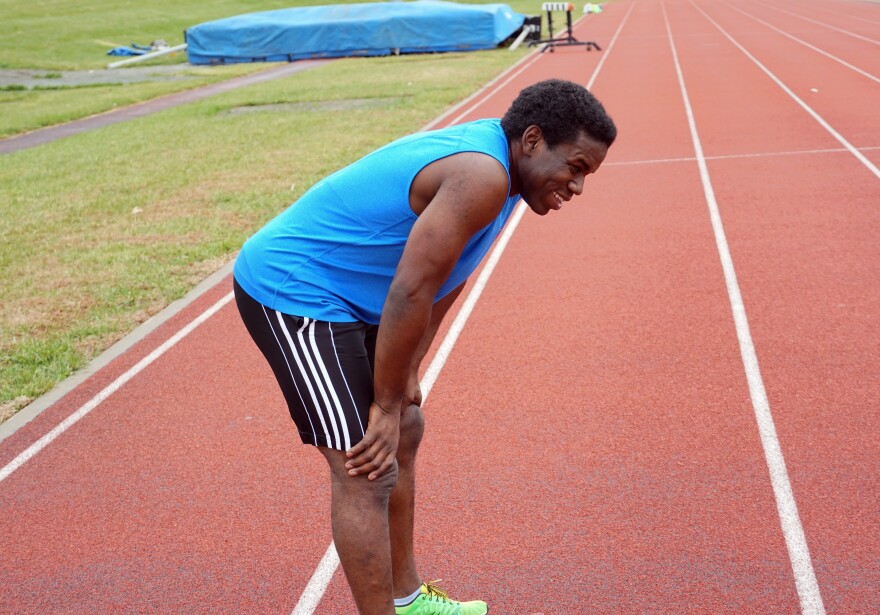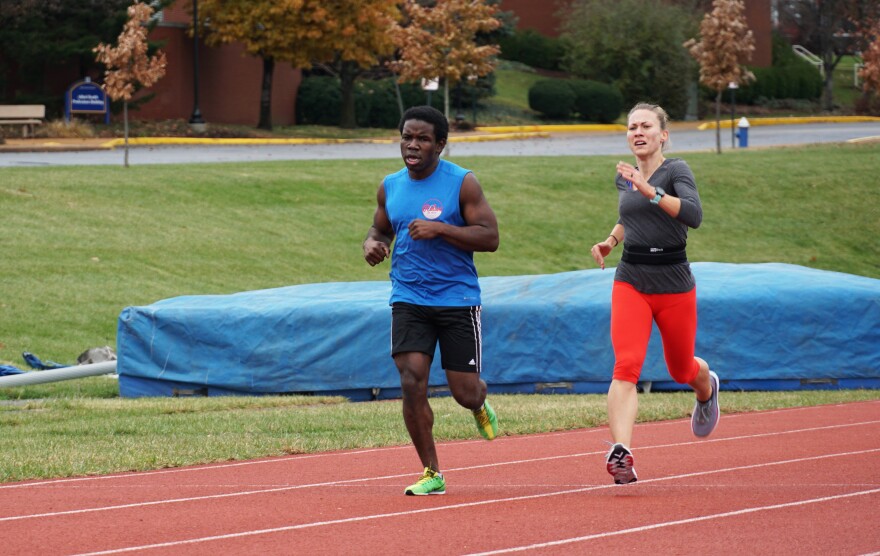Nick Silver started losing his eyesight when he was 4 years old.
He’s now almost completely blind, but the 33-year-old refuses to let his disability slow him down. The Lemay resident is training for his first half-marathon with the help of fellow runners, who jog with him and alert him to upcoming obstacles.
“It’s that comfort level knowing I can run free and there’s a set of eyes that are babysitting me,” Silver said. “I don’t have to worry about tripping over a curb or a branch or missing a step.”
On a windy Saturday morning in December, he met up with Liz Houghton at the St. Louis University track.
The two initially connected online, after Silver posted on a Facebook running club page that he was looking for guides to run with him.
Before getting started, the pair map out obstacles on the track, including a pile of hurdles and another group of runners.
Silver still has some limited vision, but his surroundings often resemble blurry shapes. When he gets tired, he says the world starts to look like a fuzzy TV screen.
“I know it seems like I can see very well, but I really can’t,” Silver said. “As we get more into it, my vision will start fatiguing and my brain will start shutting down.”

The pair run 200-meter sprints around the track, as Silver’s two young daughters shout encouragement from the sidelines.
At one point, Houghton, who lives in Glen Carbon, Illinois, admits she struggles with maintaining her speed during the sprints.
“I struggle with sight, so we’re good,” Silver responds wryly.
Developing a community of guides
Silver started losing his eyesight as a young child, after he developed juvenile-onset cataracts and uveitic glaucoma.
He also suffered from retinal detachments, a serious condition in which the thin layer of tissue that lines the inside of the eye pulls away. For this reason, he wasn’t allowed to do many sports while enrolled in the Pattonville School District.
At age 15, he transferred to the Missouri School for the Blind, where his coaches encouraged him to try track and field.
“They were like, ‘Come on out. Come show us what you can do,’” Silver said. “And from there on, I was that track star.”
Silver continued running after high school, but he was no casual athlete. In 2008, he competed in the Atlanta Paralympic Trials in track and field.
But as he’s aged, his sight has gotten worse, making it more difficult to run.

His guide community has become a lifeline for Silver, because he no longer feels comfortable running alone. To build his community, he did a social media “blitz” last fall, posting calls for running buddies across the Internet.
Tower Grove East resident John Zarbock was scrolling through Facebook last November, when a post from Silver caught his eye.
“I’ve never done anything like this before, and it just kind of spoke to me,” said Zarbock, a U.S. Army veteran who owns Freedom Fitness gym in St. Louis. “How inspiring is it to be that limited in sight and want to run?”
They met in Forest Park for their first run, and as they started jogging, Zarbock quickly realized that guiding Silver could be a helpful distraction.
“I’m so focused on what I’m doing for him as opposed to how tired I am,” he said. “Like, ‘You’re not tired. You’re not allowed to be tired, because you’re here to help.’”
‘I can’t see, but I’m still a man’
Silver has been recruiting guides in St. Louis over the past several months, partly to help him train for the Houston half-marathon Jan. 20.
In his view, however, building a community of running partners isn’t simply a matter of self-interest. Silver believes people with disabilities are often written off by society, and he hopes to change that.
“I can’t see, but I’m still a man. I’m still a father, and I still have a brain,” Silver said.
Silver has been working with a visually impaired college student to start a St. Louis chapter of Achilles International, a nonprofit that works to encourage people with all forms of disabilities to compete in mainstream athletics.
“I’m just trying to open people’s minds up to this world of people with disabilities,” Silver said.

Achilles International has chapters in cities across the U.S., including Chicago, Nashville, and Los Angeles.
Dick Traum, the organization’s president and founder, lost his leg at age 24 when a car hit him while he was pumping gas.
More than a decade after his accident, he began teaching himself how to run with a prosthetic leg — a movement he calls the little “hop and a skip.”
“There’s a certain feeling of joining society and of being out there, of not being considered frail,” Traum said.
Achilles International encourages runners with all types of disabilities — including visually impaired athletes — to take part in long-distance running,
Traum estimates more than 1,500 visually impaired runners have participated in marathons across the U.S. in the last decade.
Although the St. Louis chapter is still in its early stages of development, Silver and his collaborators hope to get it up and running later this spring.
“When doors are open, I try running through them,” Silver said. “Because plateauing is not fun. Up and forward is the only way I know to go.”
Follow Shahla on Twitter: @shahlafarzan
Send questions and comments about this story to feedback@stlpublicradio.org.
Support Local Journalism
St. Louis Public Radio is a non-profit, member-supported, public media organization. Help ensure this news service remains strong and accessible to all with your contribution today.


